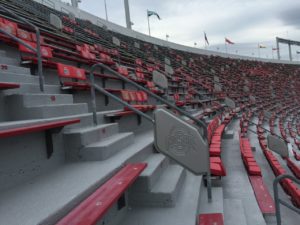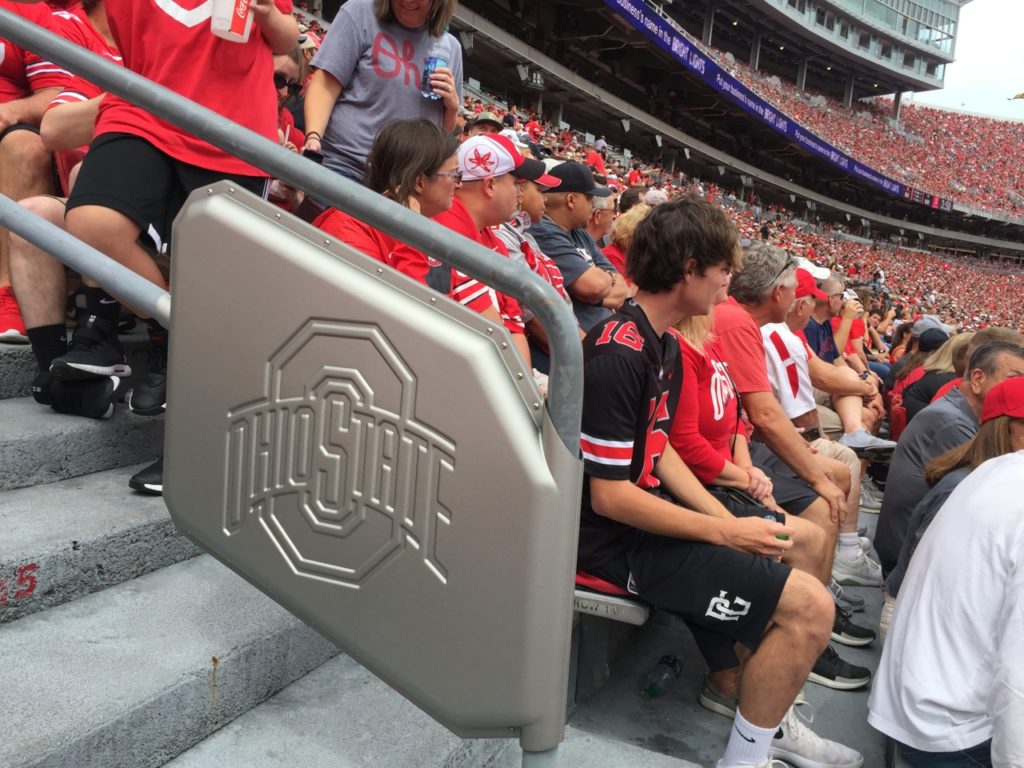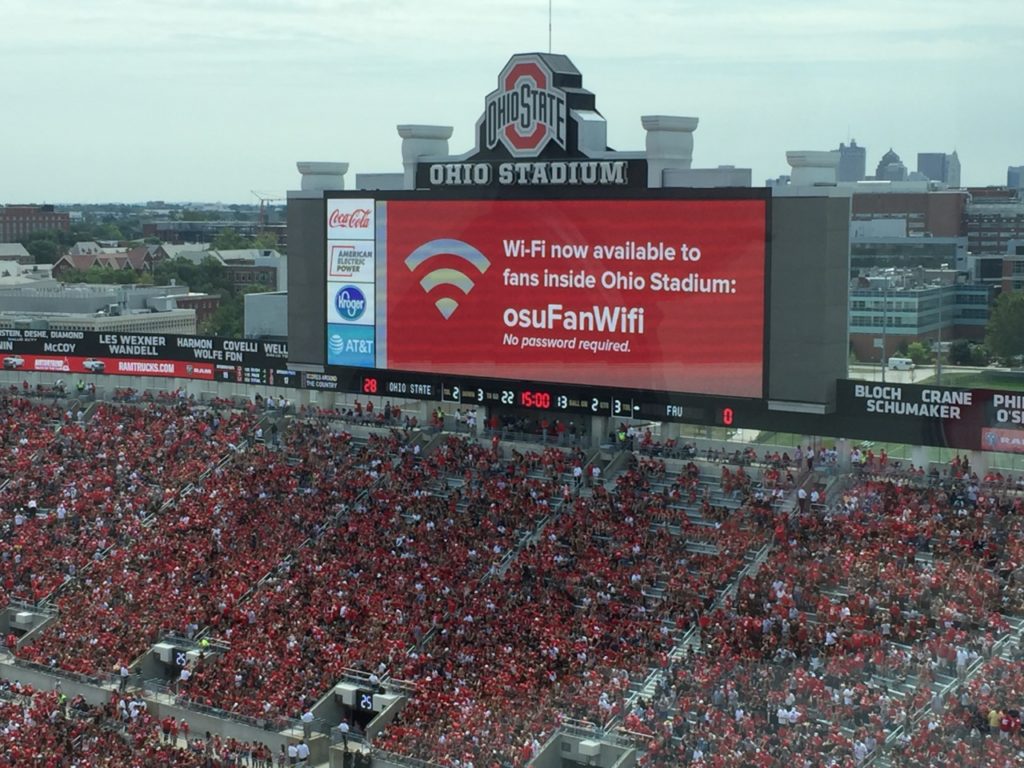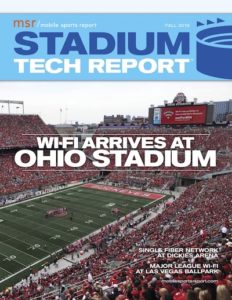
Wi-Fi enclosures in the handrails at Ohio Stadium’s upper deck. Credit all photos: Paul Kapustka, MSR (click on any picture for a larger image)
In front of a packed house Saturday night at Ohio Stadium, the Ohio State University not only gained an important Big 10 conference victory, it also broke the all-time record for most Wi-Fi data used during a single-day event, with 25.6 terabytes used by fans on the new stadium Wi-Fi network.
The new Wi-Fi network, installed this past offseason by AmpThink using Wi-Fi gear from Aruba, a Hewlett Packard Enterprise company, had already posted the highest Wi-Fi marks for a college football event, with 13.3 TB used at the home opener on Aug. 31 and another 12.7 TB used on Sept. 7. And on Sept. 21 in a blowout of Miami of Ohio, the Ohio Stadium network saw an even higher mark of 13.7 TB used, a mark previously unreported.
It turns out those were all warm-ups to the biggest Wi-Fi day so far, which came during a prime-time TV contest against Big 10 foe Michigan State. With 104,797 fans in attendance for homecoming, the approximately 2,000 Wi-Fi access points were humming from the time the gates opened. According to statistics provided to MSR by Ohio State, the network saw an astonishing 74,940 unique connections during the 34-10 Ohio State victory, many of those on a separate SSID for Verizon Wireless customers. According to Ohio State, the peak concurrent connectivity number of 45,200 users (also a record) was seen five minutes before kickoff.
Ohio State also claims top ‘take rate’
Want the inside story on how Wi-Fi came to the Horseshoe? Read our in-depth, in-person profile of the Ohio State network deployment in the most recent issue of our STADIUM TECH REPORT, available now for free reading — no registration required!
While the numbers from Ohio Stadium Saturday top the most recent Super Bowl figures (24.05 TB seen at Mercedes-Benz Stadium) it’s worthwhile to note that there were only 70,081 fans at Super Bowl 53 compared to the 104,797 at Saturday’s game. But it’s as worthwhile to note the difficulty in design and deployment to connect an extra 30,000 fans, especially in an open-bowl venue like Ohio Stadium where the balance of seating has no overhangs above.
It’s also interesting to compare the “take rates” from the top events, since Ohio State’s topped the Super Bowl’s, with 71.5 percent of fans attending Saturday connecting to the network, compared to the previous high of 69 percent at Super Bowl 53. The most recent Super Bowl, however, still claims the title for most average data used per connected fan, with its 492.3 megabytes per user mark far ahead of Ohio State’s mark of 341.6 megabytes per connected user from Saturday.
Still to come this year for Ohio State are home games against Wisconsin on Oct. 26 and Maryland on Nov. 9, as well as a possible playoff-important matchup with Penn State on Nov. 23. A home game against top rival Michigan, however, will have to wait for 2020.
Want more info? READ OUR REPORT online right now!
THE MSR TOP 27 FOR WI-FI
1. Michigan State vs. Ohio State, Ohio Stadium, Columbus, Ohio, Oct. 5, 2019: Wi-Fi: 25.6 TB
2. Super Bowl 53, Mercedes-Benz Stadium, Atlanta, Ga., Feb. 3, 2019: Wi-Fi: 24.05 TB
3. NCAA Men’s 2019 Final Four semifinals, U.S. Bank Stadium, Minneapolis, Minn., April 6, 2019: Wi-Fi: 17.8 TB
4. Super Bowl 52, U.S. Bank Stadium, Minneapolis, Minn., Feb. 4, 2018: Wi-Fi: 16.31 TB
5. Miami (Ohio) vs. Ohio State, Ohio Stadium, Columbus, Ohio, Sept. 21, 2019: Wi-Fi: 13.7 TB
6. NCAA Men’s 2019 Final Four championship, U.S. Bank Stadium, Minneapolis, Minn., April 8, 2019: Wi-Fi: 13.4 TB
7. Florida Atlantic vs. Ohio State, Ohio Stadium, Columbus, Ohio, Aug. 31, 2019: Wi-Fi: 13.3 TB
8. Cincinnati vs. Ohio State, Ohio Stadium, Columbus, Ohio, Sept. 7, 2019: Wi-Fi: 12.7 TB
9. 2018 College Football Playoff Championship, Alabama vs. Georgia, Mercedes-Benz Stadium, Atlanta, Ga., Jan. 8, 2018: Wi-Fi: 12.0 TB*
10. Auburn vs. Florida, Ben Hill Griffin Stadium, Gainesville, Fla., Oct. 5, 2019: Wi-Fi: 11.82 TB
11. Super Bowl 51, NRG Stadium, Houston, Feb. 5, 2017: Wi-Fi: 11.8 TB
12. Pittsburgh Steelers vs. New England Patriots, Gillette Stadium, Foxborough, Mass., Sept. 8, 2019: Wi-Fi: 11.58 TB
13. Atlanta Falcons vs. Philadelphia Eagles, Lincoln Financial Field, Philadelphia, Pa., Sept. 6, 2018: Wi-Fi: 10.86 TB
14. Super Bowl 50, Levi’s Stadium, Santa Clara, Calif., Feb. 7, 2016: Wi-Fi: 10.1 TB
15. Taylor Swift Reputation Tour, Gillette Stadium, Foxborough, Mass., July 27, 2018: Wi-Fi: 9.76 TB
16. Minnesota Vikings vs. Philadelphia Eagles, NFC Championship Game, Lincoln Financial Field, Philadelphia, Pa., Jan. 21, 2018: Wi-Fi: 8.76 TB
17. Jacksonville Jaguars vs. New England Patriots, AFC Championship Game, Gillette Stadium, Foxborough, Mass., Jan. 21, 2018: Wi-Fi: 8.53 TB
18. Taylor Swift Reputation Tour, Broncos Stadium at Mile High, May 25, 2018: Wi-Fi: 8.1 TB
19. Kansas City Chiefs vs. New England Patriots, Gillette Stadium, Foxborough, Mass., Sept. 7, 2017: Wi-Fi: 8.08 TB
20. SEC Championship Game, Alabama vs. Georgia, Mercedes-Benz Stadium, Atlanta, Ga., Dec. 1, 2018: Wi-Fi: 8.06 TB*
21. Green Bay Packers vs. Dallas Cowboys, Divisional Playoffs, AT&T Stadium, Arlington, Texas, Jan. 15, 2017: Wi-Fi: 7.25 TB
22. Stanford vs. Notre Dame, Notre Dame Stadium, South Bend, Ind., Sept. 29, 2018: 7.19 TB
23. (tie) Southern California vs. Notre Dame, Notre Dame Stadium, South Bend, Ind., Oct. 21, 2017: 7.0 TB
Arkansas State vs. Nebraska, Memorial Stadium, Lincoln, Neb., Sept 2, 2017: Wi-Fi: 7.0 TB
24. Tennessee vs. Florida, Ben Hill Griffin Stadium, Gainesville, Fla., Sept. 21, 2019: Wi-Fi: 6.94 TB
25. WrestleMania 32, AT&T Stadium, Arlington, Texas, April 3, 2016: Wi-Fi: 6.77 TB
26. Wisconsin vs. Nebraska, Memorial Stadium, Lincoln, Neb., Oct. 7, 2017: Wi-Fi: 6.3 TB
27. Super Bowl 49, University of Phoenix Stadium, Glendale, Ariz., Feb. 1, 2015: Wi-Fi: 6.23 TB
Fans at the home opener on Aug. 31 next to one of the handrail AP enclosures
Ohio Stadium video boards helped fans find the Wi-Fi network









